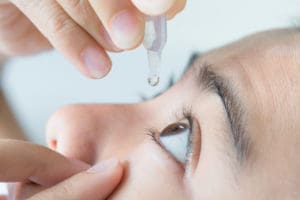How to Address Eye Problems From Rheumatoid Arthritis
Home / Eye Conditions & Eye Diseases /
Last Updated:
Dry eyes associated with rheumatoid arthritis may be treated with some over-the-counter medications, prescription medications, and other medical treatments. There are also some home remedies or alternative treatments that can help.
Rheumatoid arthritis is an autoimmune disease that affects the joints, but it may affect other areas of the body as well. Outside of joint issues, one of the major symptoms of rheumatoid arthritis is dry eyes.
If you have dry eyes as a result of rheumatoid arthritis, have your physician check for another autoimmune disease, Sjogren’s syndrome.
Rheumatoid arthritis may also be associated with inflammation, irritation, and pain in the eyes. Inflammation may be linked with numerous symptoms. Talk to a doctor about potential treatments for inflammation and pain.
Rheumatoid Arthritis and Your Eyes
While rheumatoid arthritis primarily affects the joints, it can also affect other body parts, including the eyes. The main reason the eye is susceptible to rheumatoid arthritis (RA) is that most of its parts are made of collagen. Thus, any disease affecting the collagen, which RA does, will affect the eyes. The sclera and the cornea are entirely collagen.
How Does Rheumatoid Arthritis Affect the Eyes?
The main ways in which RA can affect your eyes are:
You deserve clear vision. We can help.
With 135+ locations and over 2.5 million procedures performed, our board-certified eye surgeons deliver results you can trust. Your journey to better vision starts here.
- Keratoconjunctivitis Sicca (Dry Eye Syndrome): The inflammation that RA causes can negatively affect tear glands, reducing fluid secretion resulting in dryness. The symptoms include a feeling of dirt or debris in the eyes, redness ad blurred vision.
- Scleritis: In this condition, RA causes inflammation on the sclera (white part of the eye), which becomes thinner with the swelling and can easily split with a minor injury. It is more likely to happen among people between 40 to 70 years old. Symptoms of scleritis include reddening that does not fade, itchiness, sporadic vision problems, pain and swelling.
- Uveitis: In Uveitis, RA causes inflammation in the uvea. Uvea is the vascular section of the eye found between the retina (the back of your eye) and the sclera. Symptoms of the condition include pain, redness, light sensitivity, and blurred vision.
The different eye conditions that RA causes call for immediate doctor’s attention and treatment. Left unchecked, they could easily cause scratching, scarring, and even ulceration of the cornea. These or other negative effects of the conditions can lead to loss of vision.
Dry Eyes
One of the most common extra-articular effects of rheumatoid arthritis is dryness in the eyes.
Dry eyes can be irritating, itching, and even painful. If chronic, the condition can make your eyes more prone to infection. Chronic dry eyes is a condition where you cannot produce enough tears.
With dry eyes, you may experience inflammatory damage to the cornea of the eye, the clear outer protective layer of the eye.
If you are experiencing dry eyes and you have rheumatoid arthritis, discuss the situation with your physician. Your physician may prescribe medication or simply take a wait-and-see approach, but they should be monitoring the situation.
Over-the-Counter Drugs for Dry Eyes

A popular over-the-counter (OTC) medication is the use of eye drops called artificial tears. These will simply moisten the eyes and may need to be applied several times a day.
Do not use eye drops that are designed to reduce redness because they may irritate your eyes.
There are some ointments that are sold OTC that may also be useful. Discuss these with your physician
Prescription Medications for Dry Eyes
You might get a prescription medication from your doctor to address dry eyes. Most of these focus on reducing inflammation, or they may be antibiotics. Restasis (cyclosporine) can be used to treat inflammation.
If regular OTC medications are not working, your physician might consider using eye inserts (small clear tubes of medication that go in your eye like contacts) to address the situation.
Procedures to Address Dry Eyes
There are some medical procedures that might be considered for dry eyes, including:
- The use of special contacts designed to protect the surface of your eye and prevent moisture from escaping.
- A procedure known as the LipiFlow Thermal Pulsation to clear blocked oil glands in the eye.
- A procedure using punctal plugs made of silicone to block your tear ducts. This can help to retain moisture in the eyes.
Alternative Treatments
If you have chronic dry eyes as result of rheumatoid arthritis, you may also want to try some at-home remedies and alternative therapies in addition to medical treatments.
- Take omega-3 supplements. These may reduce inflammation in your body and lessen dry eyes. Alternatively, you could eat more salmon, sardines, flaxseed, and other foods that have omega-3 fatty acids in them.
- Use castor oil eye drops. These may reduce tear evaporation, but discuss this with your doctor before you try it.
- Apply a warm, wet washcloth over your eyes for five minutes several times a day, or massage your eyelids with a mild soap. Again, discuss this with your doctor first.
- Wear sunglasses with side eye shields.
- Limit exposure to secondhand smoke. If you smoke, stop.
- Stay hydrated.
- Discuss intense pulsed light therapy with your physician. There is at least one research study that suggests it may be useful in dealing with chronic dry eyes.
Sjogren’s Syndrome
Discuss the possibility that you may have Sjogren’s syndrome with your doctor. This is an autoimmune disease that may occur in conjunction with rheumatoid arthritis in some people.
The disease attacks the glands that make tears and saliva. It causes chronic dry mouth and dry eyes, and it affects other parts of the body.
Inflammation and Irritation of the Eyes Due to Rheumatoid Arthritis
Inflammation, redness, and irritation of the eyes may occur in people who have rheumatoid arthritis. Certain types of eye inflammation are associated with rheumatoid arthritis.
- Iritis is the inflammation of the iris, or colored part of your eye. Irritation can produce blurred vision, floaters in your sight, or other visual problems.
- Scleritis is inflammation of the sclera, the white outer layer of the eye. You will most likely experience irritation, pain, sensitivity to light, and even visual problems if you develop this.
- Uveitis occurs at the very center of the eye, or the uvea. The symptoms are very similar to the symptoms associated with iritis.
You deserve clear vision. We can help.
With 135+ locations and over 2.5 million procedures performed, our board-certified eye surgeons deliver results you can trust. Your journey to better vision starts here.
Other Symptoms
In addition to the above symptoms, you may also experience the following:

- Pain
- Burning
- Itching
- Redness
- Watery eyes
- A gritty feeling in your eyes
- Your eyelids sticking together
If you have any type of discharge from your eyes, it may signal a bacterial infection. Immediately see your physician.
Treatment for Eye Issues Related to Rheumatoid Arthritis
If you have any of the above symptoms, your physician will decide on the appropriate treatment for inflammation, given your situation. Treatment may include antibiotics, antiviral drops, corticosteroids, or other types of care.
Using a warm compress across your eyes can relieve some of the irritation associated with inflammation. Keep your hands clean, especially if you touch your eyes at all. If you use contacts, remove them until you discuss your problems with your physician.
Rheumatoid arthritis medications may also result in side effects that could affect your eyes. Discuss this possibility with your physician.
Preventing Rheumatoid Arthritis
The best way of approaching any condition is to stop it from happening in the first place through prevention measured. Unfortunately, there is little known about RA’s specific cause, so prevention may not be completely fool proof. It does, however, mitigate most of the risk factors associated with the condition. The main prevention steps are:
- Stop smoking
- Limit intake of alcohol
- Maintain a healthy weight and diet
- Improve your oral health
- Reduce environmental factors
Stop Smoking
Smoking – and even exposure to cigarette smoke on a consistent basis – is a leading risk factor for RA. Cigarette smokers have twice as high a risk for developing RA as non-smokers, and the habit affects your immune system.
Limit Alcohol Intake
Research shows that long-term-controlled alcohol intake reduces the risk of RA among women. It can also affect the medications you are taking for RA, so you should consult your doctor about it.
Improve Oral Health
A 2017 study by John Hopkins University found that bacteria that cause chronic periodontitis could also be the same that trigger RA. Keeping your teeth in good oral health will help prevent inflammation that triggers conditions like RA.
Maintain Healthy Weight and Diet
Maintaining a healthy weight for your size is vital in reducing the risk of RA since various studies link obesity and RA. Further, a good diet is vital in further lowering the risk of RA and managing its progression.
Foods to include in your regular diet include fish, especially salmon, five or more servings of fruits and vegetables each day, low-fat dairy and vegetarian meals.
Reduce Exposure to Environmental Factors
Exposure to certain environmental pollutants early in life increases the risk of RA. It is best to avoid harmful chemicals and substances like asbestos and silica. These are usually easy to avoid unless you find yourself living in houses or buildings that are 50 years or older, especially ones that have not been updated.
If you do find yourself in older living conditions, you want to be aware of cracked ceiling tiles, exposed walls, pipes and insulation.
You deserve clear vision. We can help.
With 135+ locations and over 2.5 million procedures performed, our board-certified eye surgeons deliver results you can trust. Your journey to better vision starts here.
References
- RA Eye Problems: What Eye Problems Result from Rheumatoid Arthritis? (October 2018). Rheumatoid Arthritis Support Network.
- A Single LipiFlow® Thermal Pulsation System Treatment Improves Meibomian Gland Function and Reduces Dry Eye Symptoms for 9 Months. (April 2012). Current Eye Research.
- Punctal Plugs for Dry Eyes. (January 2017). All About Vision.
- A Randomized Controlled Trial of Omega-3 Fatty Acids in Dry Eye Syndrome. (July 2013). International Journal of Ophthalmology.
- Intense Pulsed Light Treatment for Dry Eye Disease Due to Meibomian Gland Dysfunction; A 3-Year Retrospective Study. (January 2015). Photo Medicine and Laser Surgery.
- Sjogren’s Syndrome. (June 2019). MedlinePlus.
- Iritis and Uveitis. (January 2019). Medscape.
- Rheumatoid Arthritis and Your Eyes (July 17, 2020). WebMD.
- Preventing Rheumatoid Arthritis. (August 9, 2021). Verywell Health.
This content is for informational purposes only. It may have been reviewed by a licensed physician, but is not intended to serve as a substitute for professional medical advice. Always consult your healthcare provider with any health concerns. For more, read our Privacy Policy and Editorial Policy.